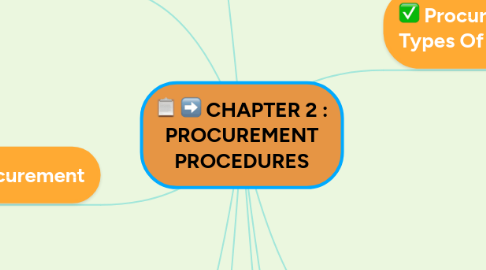
1. Procurement Order Cycle Standard Procedure
1.1. Identification of requisition material.
1.2. Determination of possible supplier
1.3. Preparation of purchase order (PO)
1.4. Following up and expedited delivery
1.5. Preparation of document
1.5.1. RFP
1.5.2. RFI
1.5.3. RFQ
1.5.4. Solicitations
1.5.5. Offers
1.5.6. Contracts
1.5.7. Amendment or Modification
1.6. Product storage
1.7. Receiving and handling invoice
1.8. Issuing payment
2. Procurement For Different Types Of Item
2.1. Raw materials
2.2. Components
2.3. Work in progress
2.4. Consumables product
3. Implementation Of e-Procurement
3.1. Definition of e-Procurement : the business to business (B2B) purchasing of goods and services through the internet.
3.2. Drivers of e-Procurement
3.2.1. Business efficiency , globalization or competition advantages
3.2.2. Need to meet government target
3.2.3. More accurate and secure in supplier management and communication
3.2.4. Slicker , more streamlined processes and purchasing
3.2.5. Best value in terms service, product and price
3.2.6. Reduction in processing cost
3.2.7. Increase customer satisfaction
3.3. Benefits of practicing e-Procurement
3.3.1. Cost saving
3.3.2. Time saving
3.3.3. Accuracy
3.3.4. Track ability
3.3.5. Benefits to the suppliers
3.3.6. Using technology
4. Challenges in e-Procurement
4.1. An inability to integrate with existing ERP and procurement systems
4.2. An inability to on board and support a large number of suppliers
4.3. Complex and unintuitive user interface
5. Development of e-Procurement
5.1. Types of spending ( Direct and Indirect )
5.2. Contract purchase vs spot purchase
5.3. Vendor recruitment
5.4. Access to large B2B forums
5.5. Electronic auction ( e-auctions )
6. Features of an e-Procurement platform
6.1. Research
6.2. Manage vendors
6.3. Create authorization or approval routing
6.4. Request quotes and bids
6.5. Make purchases
6.6. Check order status
6.7. Handle receivables
7. Important sell side capabilities that will attract vendors
7.1. Manage buyers
7.2. Manage catalogs
7.3. Promote products and services
7.4. Respond to quotes and bods
7.5. Accept orders
8. E-procurement : how to start
8.1. Just tap into a service provider that offers a hosted, yet customizable, e-procurement platform
9. Purchase preparation
9.1. Determine procurement strategy
9.1.1. The types of goods to be sourced
9.1.2. Contract versus spot buys
9.1.3. Vendor recruitment plan
9.2. Determine purchase policies
9.2.1. Authorization a
9.2.2. Approvals a
9.2.3. Access right
9.2.4. Spending limits
9.3. Determine financial settlement and logistics needs
9.3.1. Payment
9.3.2. Shipping
9.3.3. Receiving
9.4. Determine integration needs between e-procurement platform and back-end systems
10. Vendors preparation
10.1. Put products and service online
10.1.1. Create an electronic catalog
10.2. Determine sales terms
10.2.1. Pricing
10.2.2. Discount
10.2.3. Contract buyer terms
10.3. Determine financial settlement and logistics
10.3.1. Invoicing
10.3.2. Payment terms
10.3.3. Shipping
10.4. Determine promotion plans
10.4.1. Advertising
10.4.2. Sales

